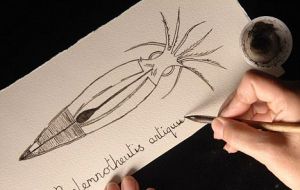MercoPress. South Atlantic News Agency
Ink from fossilized squid 150 million years old found in Wiltshire
 A picture of the creature and its Latin name was drawn using its ink.
A picture of the creature and its Latin name was drawn using its ink. Palaeontologists have drawn with ink extracted from a preserved fossilised squid uncovered during a dig in Trowbridge, Wiltshire.
The fossil, thought to be 150 million years old, was found when a rock was cracked open, revealing the one-inch-long black ink sac. A picture of the creature and its Latin name was drawn using its ink.
Dr Phil Wilby of the British Geological Survey said it was an ancient creature similar to the modern-day squid.
“The structure is similar to ink from a modern squid so we can write with it,” he said.
The find was made at a site which was first excavated in Victorian times where thousands of Jurassic fossils with preserved soft tissues were found.
Dr Wilby, who led the excavation, said: “We think that these creatures were swimming around during the Jurassic period and were turned to stone soon after death. It's called the Medusa effect.”
Experts believe one possibility is that thousands of the creatures congregated in the area to mate before being poisoned by algae in the water.
Remains of a different species of squid have also been found, suggesting the carcasses attracted predators to feed on them and they in turn also died.
Dr Wilby said: “They can be dissected as if they are living animals, you can see the muscle fibres and cells.
”It is difficult to imagine how you can have something as soft and sloppy as an ink sac fossilised in three-dimension, still black, and inside a rock that is 150 million years old.”
The specimen is now in the British Geological Survey collection in Nottingham.
Part of the ink sac has been sent to Yale University in America for more in-depth chemical analysis. (BBC)




Top Comments
Disclaimer & comment rulesCommenting for this story is now closed.
If you have a Facebook account, become a fan and comment on our Facebook Page!